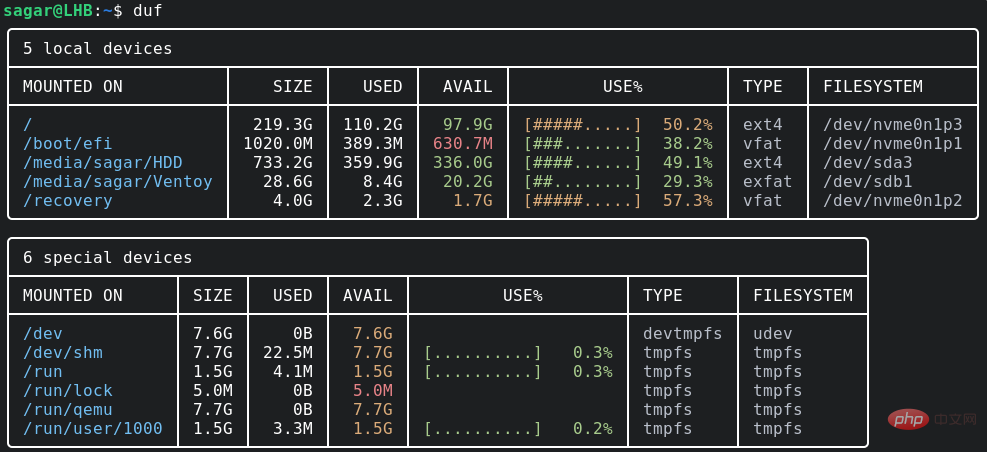 Operation and Maintenance
Operation and Maintenance
 Linux Operation and Maintenance
Linux Operation and Maintenance
 What should I do if Linux does not have the duf command?
What should I do if Linux does not have the duf command?
What should I do if Linux does not have the duf command?
Solution: 1. Use wget command to download the installation package of duf command from GitHub, the syntax is "wget https://github.com/muesli/duf/releases/download/v0.8.1/duf_0.8.1 _linux_amd64.deb"; 2. Use the dpkg command to install the duf command, the syntax is "dpkg -i duf_0.8.1_linux_amd64.deb".

The operating environment of this tutorial: Ubuntu 18.04 system, Dell G3 computer.
For analyzing disk usage, there are two very useful commands: du and df. Simply put, the functions of these two commands are as follows:
du command: It is the abbreviation of the English word disk usage and is mainly used to check how much disk space is occupied by files and directories;
df command: It is the abbreviation of the English word disk free. It is mainly used to check how much space is used on the disk, how much space is left, etc.
Especially when your disk is full, the combination of these two commands is very useful.
However, these two commands are separate after all. It would be great if they could be integrated. After all, they are the same type of commands.
Don’t mention it, someone actually integrated these two commands. It is: duf command!
duf is a cross-disk usage breakup tool written in Golang. It can output disk usage in a table (adaptive) form, and can also sort the results according to needs. It is very useful. convenient! The
duf command displays the disk space utilization, as shown in the following figure:

The result output of the duf command is more readable A structured way to examine system space.
The display is easy to read, right? Today we will share how to install and use the duf command in Linux.
Installing duf
Taking Ubuntu as an example, we cannot directly use the apt-get command to install it and need to install it manually.
First, download the duf command installation package from GitHub:
wget https://github.com/muesli/duf/releases/download/v0.8.1/duf_0.8.1_linux_amd64.deb
Then, use the dpkg command to install
dpkg -i duf_0.8.1_linux_amd64.deb
In addition, you can also install it according to its instruction manual, The address is: https://github.com/muesli/duf
Usage example of duf
Use duf to check disk usage and free space
You can use the duf command directly without adding any options, which will display a list of installed devices:
dnf

View specified devices
You can use duf to list one or more devices at the same time. You only need to specify the path where the port or device is installed:
duf
See the following example:
duf

duf utility provides various options so that you can filter the output and obtain the expected results.
For example, you can use the --only option to only display specific devices:
duf
For example, if we want to list local devices, we can use the following command:
duf --only local

If you want to view a certain file system, you can use the --only-fs option. For example, to view tmpfs (temporary file system), you can use the following command:
duf
You can use the --sort option Sort the output results based on size, usage, etc. For example:
duf
If you like the output in json format, you can use the --json option:
duf
If you want to save the results in a text file, you can redirect the results:
duf --json > duf.json
Related recommendations: "Linux Video Tutorial"
The above is the detailed content of What should I do if Linux does not have the duf command?. For more information, please follow other related articles on the PHP Chinese website!

Hot AI Tools

Undresser.AI Undress
AI-powered app for creating realistic nude photos

AI Clothes Remover
Online AI tool for removing clothes from photos.

Undress AI Tool
Undress images for free

Clothoff.io
AI clothes remover

Video Face Swap
Swap faces in any video effortlessly with our completely free AI face swap tool!

Hot Article

Hot Tools

Notepad++7.3.1
Easy-to-use and free code editor

SublimeText3 Chinese version
Chinese version, very easy to use

Zend Studio 13.0.1
Powerful PHP integrated development environment

Dreamweaver CS6
Visual web development tools

SublimeText3 Mac version
God-level code editing software (SublimeText3)

Hot Topics
 1663
1663
 14
14
 1420
1420
 52
52
 1313
1313
 25
25
 1266
1266
 29
29
 1239
1239
 24
24
 Linux Architecture: Unveiling the 5 Basic Components
Apr 20, 2025 am 12:04 AM
Linux Architecture: Unveiling the 5 Basic Components
Apr 20, 2025 am 12:04 AM
The five basic components of the Linux system are: 1. Kernel, 2. System library, 3. System utilities, 4. Graphical user interface, 5. Applications. The kernel manages hardware resources, the system library provides precompiled functions, system utilities are used for system management, the GUI provides visual interaction, and applications use these components to implement functions.
 How to check the warehouse address of git
Apr 17, 2025 pm 01:54 PM
How to check the warehouse address of git
Apr 17, 2025 pm 01:54 PM
To view the Git repository address, perform the following steps: 1. Open the command line and navigate to the repository directory; 2. Run the "git remote -v" command; 3. View the repository name in the output and its corresponding address.
 vscode Previous Next Shortcut Key
Apr 15, 2025 pm 10:51 PM
vscode Previous Next Shortcut Key
Apr 15, 2025 pm 10:51 PM
VS Code One-step/Next step shortcut key usage: One-step (backward): Windows/Linux: Ctrl ←; macOS: Cmd ←Next step (forward): Windows/Linux: Ctrl →; macOS: Cmd →
 What is the main purpose of Linux?
Apr 16, 2025 am 12:19 AM
What is the main purpose of Linux?
Apr 16, 2025 am 12:19 AM
The main uses of Linux include: 1. Server operating system, 2. Embedded system, 3. Desktop operating system, 4. Development and testing environment. Linux excels in these areas, providing stability, security and efficient development tools.
 How to run java code in notepad
Apr 16, 2025 pm 07:39 PM
How to run java code in notepad
Apr 16, 2025 pm 07:39 PM
Although Notepad cannot run Java code directly, it can be achieved by using other tools: using the command line compiler (javac) to generate a bytecode file (filename.class). Use the Java interpreter (java) to interpret bytecode, execute the code, and output the result.
 How to run sublime after writing the code
Apr 16, 2025 am 08:51 AM
How to run sublime after writing the code
Apr 16, 2025 am 08:51 AM
There are six ways to run code in Sublime: through hotkeys, menus, build systems, command lines, set default build systems, and custom build commands, and run individual files/projects by right-clicking on projects/files. The build system availability depends on the installation of Sublime Text.
 laravel installation code
Apr 18, 2025 pm 12:30 PM
laravel installation code
Apr 18, 2025 pm 12:30 PM
To install Laravel, follow these steps in sequence: Install Composer (for macOS/Linux and Windows) Install Laravel Installer Create a new project Start Service Access Application (URL: http://127.0.0.1:8000) Set up the database connection (if required)
 git software installation
Apr 17, 2025 am 11:57 AM
git software installation
Apr 17, 2025 am 11:57 AM
Installing Git software includes the following steps: Download the installation package and run the installation package to verify the installation configuration Git installation Git Bash (Windows only)





